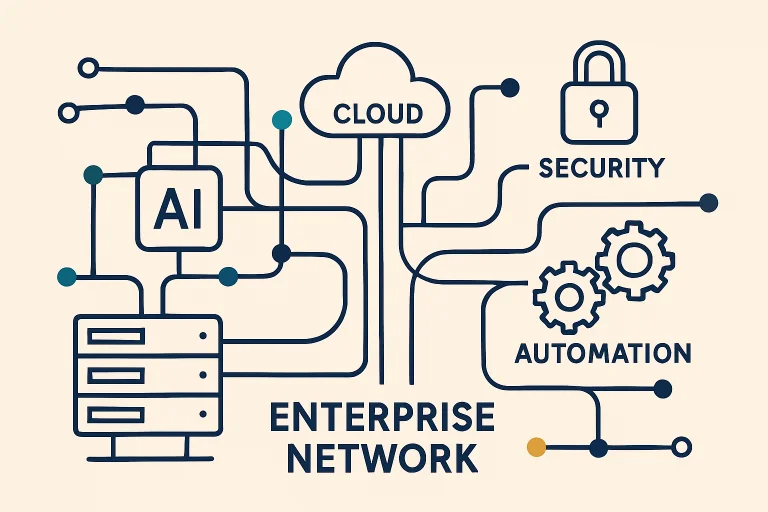Key Takeaways:
- Integrating AI and machine learning enhances network efficiency and security.
- Implementing Software-Defined Networking (SDN) and Network Function Virtualization (NFV) offers flexibility and scalability.
- Adopting Zero-Touch Networks (ZTNs) reduces manual intervention and operational costs.
- Ensuring robust security measures is crucial in modern network management.
- Continuous monitoring and optimization are essential for maintaining network performance.
Enterprises today face increasing network complexity driven by digital transformation, remote work, and evolving security threats. To stay efficient and resilient, organizations are adopting next-generation strategies that combine automation, intelligence, and security. Software-Defined Networking (SDN), Network Function Virtualization (NFV), and zero-touch automation streamline operations and improve scalability. Artificial intelligence (AI) and machine learning (ML) enhance performance through predictive analytics and proactive problem-solving. Meanwhile, Secure Access Service Edge (SASE) ensures robust, unified protection for distributed users and data. Continuous monitoring and adaptive optimization complete this approach, allowing businesses to boost agility, maintain reliability, and support seamless connectivity—key advantages for thriving in today’s fast-moving, hyperconnected enterprise landscape.
Want more like this? Explore related posts for fresh perspectives.
Introduction
Enterprises today are under relentless pressure to manage increasingly complex and geographically dispersed networks. Digital transformation, remote work, and evolving security threats require IT teams to deploy agile, reliable solutions beyond traditional frameworks. As a result, organizations are now prioritizing innovative network management strategies that optimize performance, scalability, and security while keeping operational costs in check. To address these challenges, more businesses are exploring technologies like secure SD WAN, AI-driven analytics, and network automation tools.
These solutions empower organizations to streamline connectivity, automate critical processes, and adapt rapidly to changing demands. With network environments becoming the backbone of digital operations, implementing robust, future-ready measures is no longer optional. Instead, it has become a foundational pillar for operational success and long-term growth.
Integrating AI and Machine Learning
Breakthroughs in Artificial Intelligence (AI) and Machine Learning (ML) have introduced unprecedented capabilities for enterprise network management. AI-powered platforms excel at sifting through massive volumes of network data, identifying patterns, predicting potential faults, and acting with minimal human intervention. This transformative technology allows networks to optimize routing, preemptively resolve congestion, and dynamically allocate resources to meet fluctuating demand.
For example, machine learning algorithms can continually learn from real-time traffic patterns, identifying unusual activities that may signal a potential threat or inefficiency. These innovative systems bolster operational efficiency by reducing downtime and minimizing risks associated with manual errors. As Gartner reports, AI deployments are rapidly maturing, and AI-enhanced solutions are now considered essential to modern network operations.
Implementing SDN and NFV
Software-Defined Networking (SDN) and Network Function Virtualization (NFV) are revolutionizing network design by decoupling control from hardware and enabling centralized, software-based network management. SDN abstracts the control and data planes, making automating configuration changes across multiple devices easy. This approach allows for rapid network scaling and improves agility when launching new services.
NFV complements SDN by virtualizing essential network functions—such as firewalls, load balancers, and WAN optimization—that traditionally required specialized hardware. By running these functions as software on standard servers, enterprises can reduce capital expenditures, shorten deployment cycles, and adapt infrastructure in real time to new business opportunities. SDN and NFV set the stage for a more responsive, cost-effective, and manageable network landscape. According to a report from Network World, businesses increasingly see SDN and NFV as key drivers of digital transformation in networking.
Adopting Zero-Touch Networks
Zero-Touch Networks (ZTNs) are reshaping network management by eliminating the need for manual intervention in routine tasks. ZTNs enable resources to be dynamically assigned and optimized without human oversight through automation, self-provisioning, and self-healing technologies. Leveraging AI and machine learning, these networks can detect failures, trigger corrective actions, and maintain the highest possible uptime.
Beyond increased efficiency, ZTNs significantly reduce operational costs by minimizing human intervention and accelerating deployment. Zero-touch automation also frees IT teams from repetitive chores, empowering them to focus on more strategic initiatives that drive business innovation and add value to the organization.
Ensuring Robust Security Measures
As network perimeters blur and cyber threats evolve, comprehensive security protocols are more critical than ever. Enterprises are adopting Secure Access Service Edge (SASE), which integrates SD-WAN with advanced security features like firewall-as-a-service (FWaaS), secure web gateways, and zero-trust access. This architecture provides unified security and reliable connectivity, whether users access the network remotely or on-premises.
SASE simplifies policy deployment, enforces security at the edge, and delivers consistent, context-aware protection. The combination of robust encryption, identity management, and continuous traffic inspection shields sensitive data and mitigates the risk of breaches that can disrupt business operations.
Continuous Monitoring and Optimization
Consistent monitoring is fundamental for maximizing the value of enterprise network investments. Advanced analytics platforms offer end-to-end visibility, correlating metrics across diverse network segments, applications, and user endpoints. This ongoing observation enables teams to rapidly identify bottlenecks, measure service-level performance, and address irregularities before they impact critical applications.
Routine optimization driven by performance data and predictive analytics efficiently aligns network resources with business priorities. Proactive maintenance and timely upgrades ensure the infrastructure is resilient, adaptable, and prepared to support the organization’s digital ambitions into the future.
Conclusion
Optimizing modern enterprise networks demands a thoughtful combination of innovation, automation, and continuous oversight. As organizations navigate growing digital complexity, integrating advanced technologies such as artificial intelligence (AI) and machine learning (ML) enables predictive insights, more intelligent traffic management, and faster issue resolution. Software-Defined Networking (SDN) and Network Function Virtualization (NFV) add agility and scalability, allowing networks to adapt dynamically to evolving business needs. Zero-touch automation reduces manual tasks and operational errors, while Secure Access Service Edge (SASE) strengthens protection for distributed users and data. Complemented by continuous monitoring and analytics, this integrated framework ensures optimal performance, enhanced visibility, and resilience. These capabilities empower enterprises to maximize network efficiency, safeguard critical assets, and maintain a strong competitive position in an ever-expanding digital ecosystem.
Don’t miss our featured post — top insights you’ll want to read.






